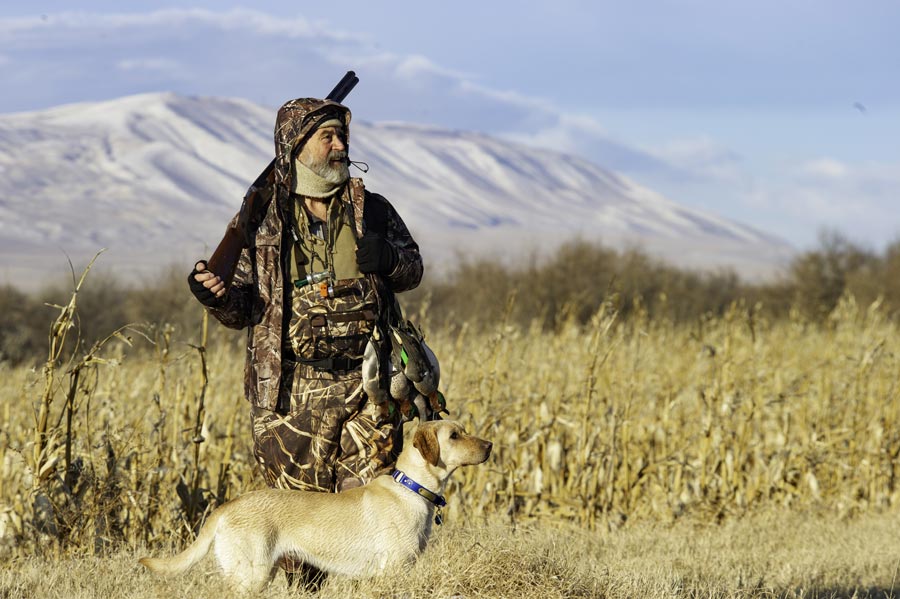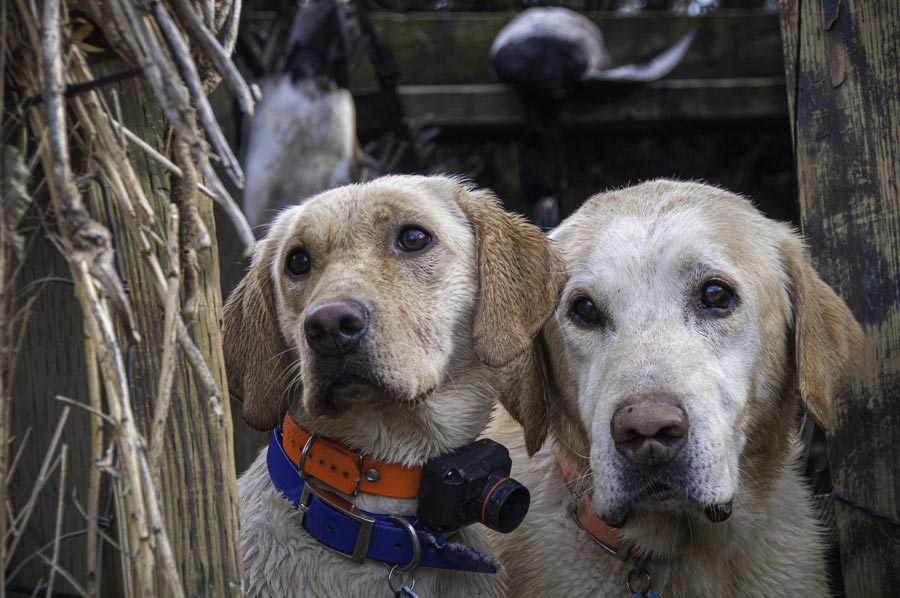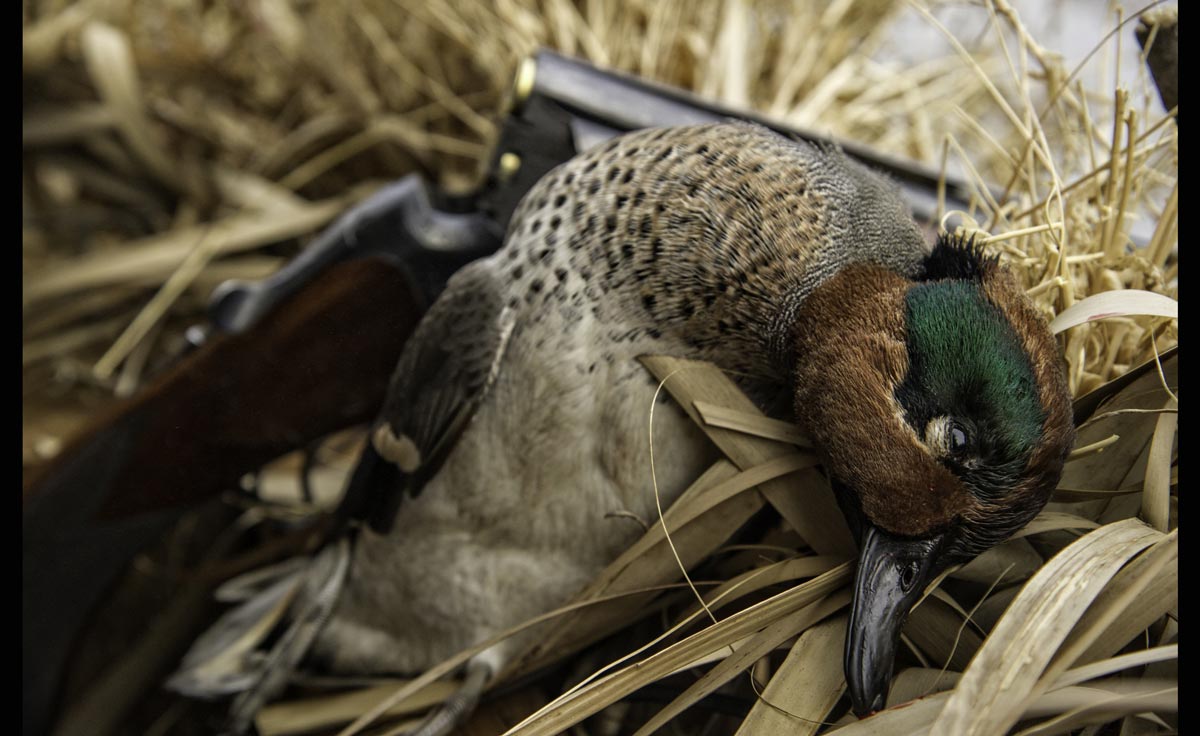Does size matter? Not in a duck blind.
Words by E. Donnall Thomas Jr.
Photos by Don and Lori Thomas
The world’s intertidal zones—those elongated ribbons of habitat where land and sea intersect and trade places every day—are magical. I have enjoyed them in many variations over the years: favorite bonefish water; the grass flats where I used to stalk bears with my bow every spring on the Alaska Coast; the sandy Cook Inlet beaches we used to land on every spring when minus tides allowed us to celebrate surviving winter by digging buckets of razor clams. These ecological niches become even more complex and inviting when a nearby river mouth creates a brackish marsh by adding a third component to the mix of land and sea: fresh water. Waxing and waning with the tides, constantly shifting salinity gradients produce unrivaled biodiversity. I love spending time in coastal marshes, especially when I’m carrying a shotgun and accompanied by a Labrador retriever.
Today, Lori and I are sitting quietly in one such location on the Texas Gulf Coast, clad in lightweight clothing even though we just celebrated Christmas. We’ve finished tossing decoys onto the water’s mirrored surface, and except for two incongruous fake snow geese, all are meant to imitate green-winged teal. The wait for legal shooting light passes so pleasantly that I almost hate for it to end. As a longtime resident of the Pacific Coast, the sight of the sun rising from the sea, while initially disorienting, eventually confirms my presence in an exotic location. This morning, the flood of pinks and oranges slowly spreading across the eastern horizon makes me imagine God controlling the process with a rheostat.
 Then there is the neo-tropical birdlife, appearing and disappearing through the wispy layer of fog blanketing the water. While it’s still too early to see color, I can identify most of these old friends by sound and silhouette: spoonbills, skimmers, ibises, a panoply of egrets and herons I won’t be able to sort out until the light level rises. Large flocks of snow geese are gabbling somewhere out in the bay, although the chances that any will visit us are slim. No matter; I’ve come to hunt teal.
Then there is the neo-tropical birdlife, appearing and disappearing through the wispy layer of fog blanketing the water. While it’s still too early to see color, I can identify most of these old friends by sound and silhouette: spoonbills, skimmers, ibises, a panoply of egrets and herons I won’t be able to sort out until the light level rises. Large flocks of snow geese are gabbling somewhere out in the bay, although the chances that any will visit us are slim. No matter; I’ve come to hunt teal.
“Check your watch,” Lori suddenly instructs me from her side of the blind. I have to salute her focus, for left to my own devices I might daydream my way right past the onset of shooting light.
“Time to load up,” I acknowledge. The metallic sound of shotgun actions opening punctuates the gentle murmur of the marsh, followed by the clink of brass against steel as shells drop into chambers. I glance around to be sure the dog isn’t misbehaving—unnecessarily as it turns out, for Rosy, our female yellow Lab, has known what was up ever since we entered the blind, and she’s sitting motionless beside me, patiently scanning the sky.
Now we’re hunting ducks at last.
 I admit that size does matter in some outdoor endeavors. My enthusiasm for big fish on the end of a fly line has led me to focus on salmon, steelhead, and saltwater. While I’m not a trophy hunter and have been open about my disdain for record books and “scores,” given a choice between a six-point bull elk and a spike I’ll probably shoot the big one, if for no other reason than the increased number of meals it will provide.
I admit that size does matter in some outdoor endeavors. My enthusiasm for big fish on the end of a fly line has led me to focus on salmon, steelhead, and saltwater. While I’m not a trophy hunter and have been open about my disdain for record books and “scores,” given a choice between a six-point bull elk and a spike I’ll probably shoot the big one, if for no other reason than the increased number of meals it will provide.
One of the pleasures of wingshooting is that shotguns and bird dogs relieve us of such concerns altogether. A quail is a quail, a pheasant is a pheasant, and—at least in my mind, although others might dispute it—a duck is a duck despite the size difference between a teal and a mallard.
This piece is simply a reflection upon my lifelong passion for hunting teal. Because I love to eat them—especially blue wings, one of our tenderest, most succulent waterfowl—I sometimes wish there was more meat to them, but other characteristics compensate for this minor shortcoming. If a group of teal and a flock of mallards drift into the decoys—I’m shooting for the teal.
Or at least shooting at them, for their speed and erratic flight patterns make them one of our most challenging waterfowl on the wing. Teal seldom work decoy spreads warily, like mallards or pintails. Instead, they are apt to arrive within shotgun range unannounced save for the sound of air rushing through their extended flight primaries. Encounters between teal and hunters tend to be brief and awkward, like adolescent sex in the backseat of a car. To compound the difficulty, teal usually arrive in tight little flocks that shatter in multiple directions the moment a shotgun barrel rises. As a result, the hunter must concentrate on isolating one bird from many while swinging at crazy angles faster than other puddle ducks demand.
 When shooting teal, I’ve trained myself not to think about my second barrel until I’m finished with my first. This practice saves ammunition and avoids embarrassment while making clean doubles a source of satisfaction. Teal also influence my choice of shotguns on mornings when I anticipate lots of them: Because teal are easy to kill if you can hit them and most shots come at close range, a light, short-barreled gun serves better than one designed for power and long range. I do a lot of teal shooting with a 20-gauge.
When shooting teal, I’ve trained myself not to think about my second barrel until I’m finished with my first. This practice saves ammunition and avoids embarrassment while making clean doubles a source of satisfaction. Teal also influence my choice of shotguns on mornings when I anticipate lots of them: Because teal are easy to kill if you can hit them and most shots come at close range, a light, short-barreled gun serves better than one designed for power and long range. I do a lot of teal shooting with a 20-gauge.
Even good shots have bad days, and my absolute worst came courtesy of blue-winged teal on the opening day of a Montana prairie duck season long ago. Generous rains that year had created a large wetland where none usually existed, and its towering cattails had grown higher than my head. I’d set up in a half-acre opening in the reeds, and teal started flying at first light. Blue wings are always the first waterfowl to depart that remote corner of the Central Flyway in the fall. The birds I encountered that morning must have been staging for migration, since they were present in greater numbers than I had ever seen there and flying nonstop around the marsh.
As light broke, teal came zooming by at high speed just over the tops of the reeds. As soon as they entered the airspace that I could see, they were almost gone—and damned if I could drive my barrels ahead of them before they disappeared. I shot holes in the sky until I’d gone through a whole box of shells and left carrying a duck dinner that could have been featured in a Weight Watchers cookbook. Fortunately, the only witness was my Lab, who already knew that what happens in the marsh stays in the marsh.
Unpredictable, erratic behavior is another teal hallmark. One never knows just what a flock of teal will do next, and I suspect the teal don’t even know themselves. Another episode from the old days neatly illustrates this characteristic, in what became known as the Affair of the Sacrificial Lamb.
 Dick, Ray, and I—accompanied by Ray’s Chessie and my Lab—had spent a long day enjoying the smorgasbord of hunting opportunities the Montana prairie offers in October. We had shot limits of sharptails by mid-morning, subsequently supplemented by a number of pheasants and Huns. The only reason we headed for home before dark was that one of us had added an antelope to the bag, and although winter weather lay just around the corner it was still too hot to leave a big game carcass in the truck all afternoon.
Dick, Ray, and I—accompanied by Ray’s Chessie and my Lab—had spent a long day enjoying the smorgasbord of hunting opportunities the Montana prairie offers in October. We had shot limits of sharptails by mid-morning, subsequently supplemented by a number of pheasants and Huns. The only reason we headed for home before dark was that one of us had added an antelope to the bag, and although winter weather lay just around the corner it was still too hot to leave a big game carcass in the truck all afternoon.
We were bouncing down one of the area’s unnamed backroads when I spotted a flock of teal resting near the lee end of a small reservoir. The idea of adding some waterfowl to our mixed bag proved too tempting to resist. But we faced a major problem: There wasn’t a lick of cover anywhere near the pond, and approaching within shotgun range looked impossible.
Like most ranch ponds in the area, however, this one owed its existence to an old earthen dam at the end opposite the teal, and a steep little coulee ran downhill from there. After studying the lie, I hatched a plan: Two of us would drive down the road, walk up the draw undetected, and hide behind the dam while the third ambled down to the other end of the water and flushed the teal over the others’ heads. Brilliant.
We needed a Sacrificial Lamb, though, and no one volunteered. I don’t know how our hunting ancestors worked these problems out before the invention of paper and scissors, but they must have experienced a lot of all-rock ties. After a couple of “One, Two, Three, Shoots,” we had the problem solved: Dick and I headed for the coulee and the dam, while Ray became the Sacrificial Lamb.
Fifteen minutes later, Dick and I were in place. Enough brush grew on the top of the dam for me to watch the plan unfold without revealing our presence to the ducks. “Get ready!” I urged Dick as I saw Ray hiking across the grass with his shotgun over his shoulder and his Chessie at heel, looking as ridiculous as I’ve ever seen a capable hunter look. “Here they come!” I announced as the teal took to the air.
Except, they didn’t. Ignoring the script, they made a tight turn halfway down the pond and flew right over Ray, who doubled smoothly. A few minutes later we were standing together near the waterline, heaping Ray with verbal abuse while the dogs recovered the fallen birds. However, the story of the Sacrificial Lamb wasn’t over yet.
As it happened, Dick had just acquired a new shotgun—a fancy double by our standards—that neither Ray nor I had yet examined. “Let me take a look at your new gun,” Ray said to Dick as we braced for the arrival of the two wet dogs. Ray handed his empty gun to Dick, who gave his to Ray to look over. I had unloaded my shotgun after our brilliant plan unraveled, but Dick had not unloaded his.
Of course, that’s when the flock of teal decided to return to the pond by flying right down the pipe in front of us. Ray, holding the only loaded gun among us, doubled again. “Nice shotgun,” he allowed, as he ejected the spent shells and the dogs went crashing back into the water. The moral of this story is that if you have a chance to be the Sacrificial Lamb on a teal hunt, take it.
Three species of teal inhabit North America. Although it’s easy to lump them together mentally and consider them as one, subtle differences among the three are worth noting.
Blue wings are the most abundant, with a 2019 continental population estimated at 5.4 million birds by the Fish and Wildlife Service (FWS). Despite a modest recent downward trend, this figure is still above the Long-Term Average (LTA). Blue wings rank with pintails as my favorite puddle ducks on the table, and I still love to hunt them despite the humiliation I suffered at their hands on that long-ago prairie opener. Because of their early migration south I don’t get to hunt them as much as I’d like, but I always make an effort to get out to local potholes early in the season just to shoot blue wings.
Most of the teal I shoot these days are green wings. The FWS data cited above estimated a continental population of 3.2 million green wings, which is currently increasing and well above the LTA. The first duck I ever shot was a green wing taken over 60 years ago while I crouched behind a farm pond dam in northern New York as my Dad flushed the bird by me. (That must have been the origin of the game plan for the Affair of the Sacrificial Lamb.) I’ve had a soft spot in my heart for them ever since.
The cinnamon teal is in many respects an outlier among the three. Although its population is stable, it is considerably less abundant than other teal, with an estimated North American population below half a million. While other teal are found from coast to coast, the cinnamon teal’s range is limited to the West. Unlike our other puddle duck species, it maintains a separate breeding population in South America, the only place I’ve ever hunted them.
That happened incidentally on a fishing trip to Argentina, where they are known as colorados (Spanish for “reds”). On the few occasions when I encountered one at home during hunting season, its striking plumage and ruby-red eye left me too transfixed to shoot. They just seemed too uncommon and beautiful. However, they were all over the Argentine marsh I hunted on that trip, and I indulged in the opportunity to shoot some with a clear conscience. By the way, they tasted great.
Despite the attraction I feel for them, most of the teal I shoot during a typical season in Montana, Washington, or Alaska—the three states where I do most of my duck hunting—come incidentally (early season local blue wings excepted). When I really want to enjoy a serious, focused teal hunt, I head to South Texas.
The first flock of green wings came roaring suddenly out of the fog as if they had mounted a surprise attack on our decoys. Lori only got her shotgun halfway to her shoulder, and the best I could do was knock down the last bird in line with my first barrel. Quivering on the seat beside me, Rosy made no secret of her readiness to launch, but I kept her in place with a few soft words while I reloaded. “Stay ready,” I advised Lori. “I just saw more teal coming out of the sunrise.”
That glimpse provided us with a few additional seconds to prepare for the second flock’s arrival, and we made the most of them. I deferred the first shot to my wife—re-establishing my tarnished reputation as a gentleman—and saw one bird tumble before turning my attention to the rest of the flock, which departed three birds shy of its initial number. Rosy’s time had come at last.
Three of the downed teal lay dead in the decoys, but the fourth bird was churning for the security of the dense cover on the far side of the pond. Using a combination of whistle and hand signals, I directed the dog past the three downed ducks we didn’t need to worry about. When she finally spotted the faint V of the swimming bird’s wake, she kicked the pace of her pursuit into overdrive and was soon bobbing for apples as the duck dove repeatedly in attempts to evade her. Rosy hadn’t lost a bird all season, and her streak remained intact throughout the morning.
Two hours later, we had nearly filled our duck limits with nothing but green wings. The fog had cleared, and the marsh lay bathed in golden sunlight. Suddenly, I looked up and saw two lost snow geese hovering over the decoys. I still don’t know how they arrived undetected, but we killed them both with easy shots.
Snow geese, Dall’s sheep, winter ptarmigan, and someone’s famous whale: Pure white is a rare color scheme in wildlife, and as Rosy retrieved the second goose I left my gun empty and took a minute to appreciate the first bird’s virginal plumage. The geese had been a welcome bonus, and they probably doubled the weight of the bag hanging on the duck strap.
They weren’t the high point of the morning, however. That honor belonged to the excitement, tough shooting, and challenging dog work the teal provided.
Size doesn’t matter in a duck blind. I rest my case.




